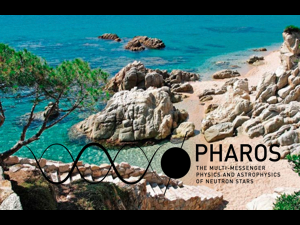Speaker
Mr
Alessio Marino
(Università degli studi di Palermo)
Description
Since 1998, when the discovery of the first Accreting Millisecond X-ray Pulsar (AMXPs) SAX J1808.4-3658 occurred, the family of these sources kept growing on. Up to now, it counts 22 members, object of several studies due to the interesting, and sometimes puzzling, behavior shown by some of them. All AMXPs are transients with usually very long quiescence periods, implying that mass accretion rate in these systems is quite low and not constant. Moreover, for some of these sources, a non-conservative mass-transfer scenario, i.e. the case where only a fraction of the transferred mass is effectively accreted onto the neutron star, was proposed.
We tried to demonstrate that a non-conservative scenario is necessary to explain the low averaged mass-accretion rate in three AMXPs: XTE J0929-314, IGR J17498-2921 and XTE J1814-338. The method used consists in calculating the expected mass-transfer rate under the hypothesis of a conservative evolution, based on their orbital periods and the mass of the secondary (as derived by the mass function). Depending on the mass of the secondary, we considered this mass-transfer as driven by gravitational radiation only or also by magnetic braking. Using this theoretical mass-transfer, we determined the accretion luminosity of the systems. Then, we compared this luminosity to the X-ray flux observed from the systems, averaged over the time elapsed since their discovery. This comparison gives a lower limit to the distance of the sources, which might be compared to the value of the distance reported in literature in order to evaluate how reasonable is the hypothesis of a conservative mass-transfer. If else the distance of the source is not known, as in the case of XTE J0929-314, the level of “unlikeliness” of the distance estimate determined by this method was used as a test for the unlikeliness of the whole conservative mass-transfer scenario.
The distance for XTE J0929-314 is shown to be >7.4 kpc in the direction of the Galactic anticentre, implying a large height, >1.8 kpc, of the source with respect to the Galactic plane, placing the source in an empty region of the Galaxy (*Marino et al., 2017*). For the other two sources in the sample, the lower limits on the distances estimated, i.e. of 10 kpc for IGR J17498-2921 and 22 kpc for XTE J1814-338 (*Marino et al., 2018*, submitted to A&A), are higher than and not compatible within the error with the known distances of both sources. These problems can be solved under the hypothesis of a non-conservative mass-transfer in which a fraction of the mass accreted onto the compact object is swept away from the system, likely due to the (rotating magnetic dipole) radiation pressure of the pulsar.
With this argument, the count of AMXPs showing non-conservative mass-transfer becomes 6 over the 22 sources discovered so far, confirming that this phenomenon might be quite common in this class of systems.
Primary author
Mr
Alessio Marino
(Università degli studi di Palermo)
Co-authors
Dr
Alessandro Papitto
(INAF, Osservatorio astronomico di Roma)
Dr
Alessandro Riggio
(Università degli studi di Cagliari)
Dr
Andrea Sanna
(Università degli studi di Cagliari)
Dr
Angelo Francesco Gambino
(Università degli studi di Palermo)
Prof.
Luciano Burderi
(Università degli studi di Cagliari)
Dr
Melania Del Santo
(INAF-IASF Palermo)
Prof.
Rosario Iaria
(Università degli studi di Palermo)
Mrs
Simonamichela Mazzola
(Università degli studi di Palermo)
Prof.
Tiziana Di Salvo
(Università degli studi di Palermo)

